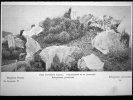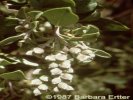 Carl Purpus, Plant
Collector in Western America
Carl Purpus, Plant
Collector in Western America 
Carl A. Purpus Translation by Barbara
Ertter
 Carl Purpus, Plant
Collector in Western America Carl Purpus, Plant
Collector in Western America | C. A. Purpus and His Introductions |
 | Carl A. Purpus Translation by Barbara
Ertter |






|
C. A. Purpus und seine Einfuhrungen. Moller's Deutsche Gartner-Zeitung. 11(10): 109-112.
|
The number of German gardeners who travel to other parts of the world as plant collectors is not limited, but only rarely does the public hear something about them. For the most part this involves the employer's stipulations, which make sure that the explorations and collecting trips were not made public. In addition, those collectors who traveled on their own accounts had the completely understandable desire to keep all other collectors from their prime collecting spots, which were often
discovered with great difficulty. According to a careful assessment, there are currently at least 50 German garderers on collecting trips who are on commission to German, Belgian, English, French,
and North American firms, and others who are independent. The great majority of their experiences are in fact transmitted in the form of variably interesting written communications of a private nature, to which the public has difficulty getting access.
|
| Today it gives us
special pleasure to provide the reader of this periodical with a summary, if only
brief, of the travels and introductions of one German collector whoe name until now has been
generally known only in the dendrological circle. We present as well his picture, a photograph taken
in a primeval forest. It shows the collector, weathered from his strenuous year-long journeys, sitting
in front of the trunk of Arbutus purpusi, discovered by him.
|
| C. A. Purpus was born
in the year 1853 on beautiful Donnersberg near Kirchheimbolanden, where
his father was the royal forester. Even in his earliest youth he displayed a huge interest in and
boundless love of nature, especially the plant kingdom. The rich flora of his home environs offered
him abundant material for the basis of his botanical studies. During a several-year-long residence in
upper Hesse, he zealously explored and collected in the floristic regions of Vogelsberg, at that time
still poorly known, and assisted with the Hessian Flora of Dosch and Scriba. Later Purpus toured
nearly the entire region of Switzerland and northern Italy, where he collected the rarest alpines as a
bold and agile mountain climber.
|
| In the years 1876-77
he studied Pharmacy in Giessen and took his civil service examination there
with brilliant results. In the year 1887 he was recruited by Dr. Dieck, the owner of the important
arboretum in Zschen, for a two-year botanical journey to North America. He traveled with his
brother, at that time head gardener in the botanical garden at Darmstadt, through Canada. During the
summer he collected in the mountains of British Columbia. In the second year he travelled with Dr.
Rll of Darmstadt in the northwestern states of North America, where he collected primarily on
Mount Hood [Oregon], the Mission Range [Montana], the Washington Territory, Montana, Idaho,
etc. His highly interesting travel descriptions of each area are for the most part published in the
periodical Ausland.
|
| We are indebted to
him for many winter-hardy plants plants from each region, many new or not widely distributed, of which the following may be emphasized: Penstemon menziesii Hook. var.
scouleri Gray, Rhododendron albiflorum Hook., Menziesia ferruginea Sm., M. glabella A. Gray, Kalmia glauca Ait. var. microphylla, Bryanthus glanduliflorus, Lonicera utahensis, Viburnum ellipticum Hook., Alnus occidentalis Dippel, Spiraea menziesii Hook., Celtis reticulata Torr., Symphoricarpos mollis Nutt., Lonicera involucrata Banks, L. ciliata Muehlenb., L. ciliosa Poir., Shepherdia argentea Nutt., S. canadensis, Berberis nervosa, Sorbus sambucifolia Roem., Crataegus
rivularis Nutt., Ceanothus velutinus, Pachystima myrsinites Raf., Rhamnus purshiana DC., Symphoricarpos occidentalis Hook., S. oreophilus Gray, Fatsia horrida Benth. & Hook., Prunus demissa Walp., Spiraea corymbosa Raf., and many more.
|
| Afterwards he
collected independently in the central United States, especially in northern Illinois
and Michigan. From here he sent unusual perennials and woody plants, particularly those of limited
distribution that are currently seldom in cultivation. He also sent many plants that until then had been
barely winter-hardy in Germany, collecting them on their northernmost limits so that they could endure our climate and be completely winter-hardy. The most noteworthy of these are: Crataegus
flava Ait., Cornus asperifolia Nutt., Ilex decidua Walt., Forestiera acuminata Poir., Rhamnus lanceolata Pursh, R. alnifolia L'Herit, Salix candida Flgg., S. longifolia Muehlenb., and others including the known-to-be-sensitive Asimina triloba Dun. and Carya olivaeformis Nutt., which have proved to be fully winter-hardy, as well as Viburnum acerifolium L. and V. pubescens, two plants very seldom known before, and the charming subshrubby Nesaea verticillata, Betula pumila X lutea,
a very interesting hybrid, and several others.
|
|  Echinocereus phoeniceus.
Echinocereus phoeniceus.
Locations: Grand Mesa. Uncompahgre Range. Letters: 1/28/1896 In the years 1892-93 he collected
in the high mountains of western Colorado, especially in the Grand Mesa and Uncompahgre Ranges, with great success. Not only was the yield of his collecting trip an abundance of interesting, splendid, woody plants, but also many beautiful alpine perennials.
The most prominent and interesting collections, however, are unquestionably the winter-hardy cacti, of which many species and forms were collected in that place. If until now we had to be content with only a few Opuntia, we now have at our disposal not only 25-30 species and forms of this genus, but also Cereus, Echinocactus, and Mamillaria, all of which have proved to be completely winter-hardy here. Several of the cacti have been determined by the famous cactus expert Prof. Dr. K. Schumann of Berlin, as for example Cereus (Echinocereus) phoeniceus Engelm., C. phoeniceus Engelm. var. inermis, a peculiar spineless form, Cereus viridiflorus Engelm., Mamillaria purpusii Schum., M. spaethiana Schum., Echinocactus glaucus Schum., and others.
|
| The shrubs of each
region are nearly all distinguished by abundant, marvelous flowers. Among
those completely new to cultivation are Ceanothus fendleri Gray, Baccharis salicina Torr. & Gray, Gilia californica Benth. (var. nova), Salix purpusii Khne, Glossopetalon meionandrum Khne, Ephedra trifurca Torr., E. nevadensis Torr., Quercus gambeli Nutt., Ribes lacustre Poir. (var. nova), Tetradymia spinosa Hook. & Arn., Grayia polygaloides Hook. & Arn., Eurotia lanata Moc.,
Sarcobatus vermiculatus Torr., various other Chenopodiaceae and shrubby Compositae, Clematis ligusticifolia Nutt., Ribes leptanthum Gray, R. tenuiflorum Lindl., completely winter-hardy Yucca baccata, the rare and marvelous shrub Fendlera rupicola Engelm. & Gray, Cercocarpus parvifolius Nutt., Peraphyllum ramosissimum Nutt., Berberis fremontii Torr., Artemisia tridentata Pursh, A. frigida W., Populus fremontii S. Wats., P. angustifolia James, Pachystima myrsinites Raf., and Betula
occidentalis Gray.
|
| Herr L. Spth, owner
of the renowned nurseries in Rixford, obtained the woody plants and cacti,
while Herr Sndermann of Lindau i. Bodensee, the foremost alpine plant grower, received the
alpines. Prominent among the alpines are Townsendia wilcoxiana Wood., Penstemon hallii Gray, P.
watsonii Gray, Primula parryi Gray, Polemonium confertum Gray, Chionophila jamesii, Caltha
leptosepala DC., Phacelia sericea Gray, Ranunculus macauleyi Gray, Smelowskia calycina C. A.
Mey., Synthyris alpina Gray, lovely Erigeron, Aster, Trifolium, and many others.
|
|  Garrya pallida var. flavescens.
Garrya pallida var. flavescens.
In subsequent years [1894] Purpus
visited the Coast Ranges of northern California, again with
great success. Many unusual woody plants and perennials new to cultivation were the result. To
name some of the former: Rhamnus purshiana DC. var. intermedia Khne, Ceanothus cordulatus Kell., Rhamnus californica Eschsch. var. tomentella, R. californica var. purpusii Khne, Euonymus occidentalis Nutt., Garrya flavescens S. Wats., Arbutus purpusii Khne, Pickeringia montana Nutt., Penstemon davidsoni Greene, P. sonomensis Greene, P. corymbosa Benth., P. lemmoni A. Gray,
Alnus rhombifolia Nutt., Quercus dumosa Nutt. var. bullata Engelm., Q. vaccinifolia, Q. wislizenii, Q. chrysolepsis, and others. Examples of the perennials are: Aralia californica, Paeonia brownii, splendid Eriogonum, an Apocynaceae, beautiful ferns, Vesicaria, Aquilegia, Iris, and Dodecatheon, the last still undescribed. [CHECK TRANSLATION]
|
| Locations: Mount Whitney. Last summer [1895]
Purpus visited botanically little-known parts of the southern and southeastern
Sierra Nevada of California, collecting particularly on Mt. Whitney and surroundings areas. The yield
of this collecting trip consisted primarily of a great abundance of marvelous and very valuable alpine
and subalpine perennials. The quantity of woody plants and annuals was hardly less.
| |
[Next Page] | |
| [Published Biographies] [Travelogues and Articles] [Letters] [Plant Lists and Bibliography] [Site Administration] | | Date and time this article was prepared: 6/7/2002 7:32:06 PM |